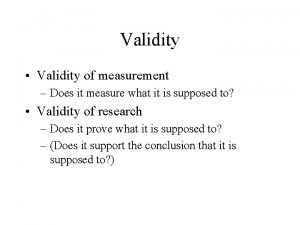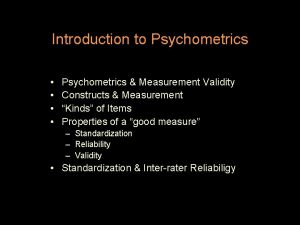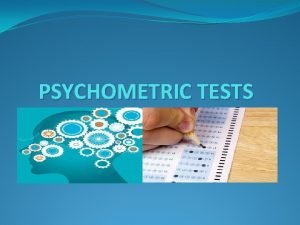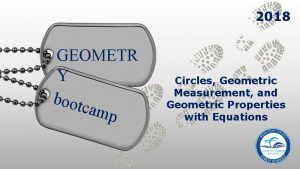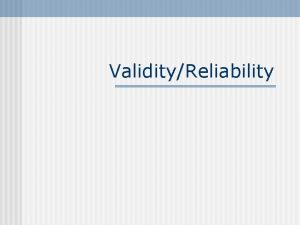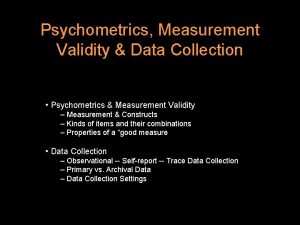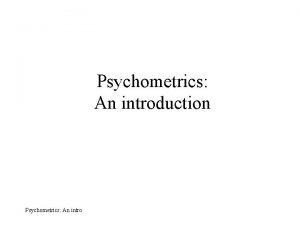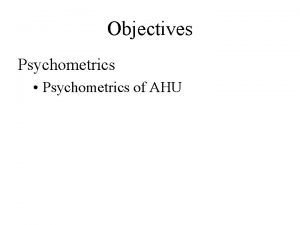Psychometrics Validation Psychometrics Measurement Validity Properties of a












- Slides: 12

Psychometrics & Validation • Psychometrics & Measurement Validity • Properties of a “good measure” – Standardization – Reliability – Validity • A Taxonomy of Item types

Psychometrics (Psychological measurement) The process of assigning values to represent the amounts and kinds of specified attributes, to describe (usually) persons. • We do not “measure people” • We measure specific attributes of a person Psychometrics is the “centerpiece” of empirical psychological research and practice. • All data result from some form of “measurement” • What we’ve meant by “Measurement Validity” all along • The better the measurement, the better the data, the better the conclusions of the psychological research or application

Desirable Properties of Psychological Measures Interpretability of Individual’s and Group’s Scores Population Norms (Typical Scores) Validity (Consistent Accuracy) Reliability (Consistency) Standardization (Administration & Scoring)

Standardization • Administration -- “given” the same way every time • who administers the instrument • specific instructions, order of items, timing, etc. • Varies greatly -- multiple-choice classroom test (hand it out) -- Intelligence test -- 100+ pages of “how to” in manual -- about 1/2 semester in Psych 955 • Scoring -- “graded” the same way every time • who scores the instrument • correct, “partial” and incorrect answers, points awarded, etc. • Varies greatly -- multiple choice test (fill in the sheet) -- Exner System for the Rorschach -- 2 weeks of in depth training

Reliability (Consistency) • Inter-rater or Inter-scorer reliability • can two raters produce the same score for a given test (assumes standardization) • Internal reliability -- agreement among test items • split-half reliability -- randomly split into two tests & correlate • Chronbach’s -- tests “extent to which items measure a central theme” • External Reliability -- consistency of scores from whole test • test-retest reliability -- give same test 3 -12 weeks apart ( r ) • alternate forms reliability -- two “versions” of the test ( r )

Validity (Consistent Accuracy) • Criterion-related Validity -- does test correlate with “criterion”? • statistical -- requires a criterion that you “believe in” • predictive, concurrent, postdictive validity • Content Validity -- do the items come from “domain of interest”? • non-statistical -- decision of “expert in the field” • Face Validity -- do the items come from “domain of interest” • non-statistical -- decision of “target population” • Construct Validity -- does test relate to other measures it should? • Statistical -- Discriminant validity • convergent validity -- correlates with selected tests • divergent validity -- doesn’t correlate with others

Kinds of Items Survey Items • individual items expected to “capture” the attribute of interest • e. g. , age, height, political registry Scale Items • items that are expected to “capture” the attribute of interest only when aggregated together to form a scale • e. g. , emotional maturity, body image, liberalism-conservatism Psychometrics emphasizes the measurement of relatively complex attributes, and so, emphasizes the use of multi-item scales (made up of of absolute, similarity, sentiment items)

More about “kinds of items” Any item can be defined by specifying three central attributes… Judgment item vs. Sentiment item • judgments -- have “correct answers” • sentiments -- have no “correct answers” Comparative item vs. Absolute item • responding to two or more “stimuli” • responding to a single “stimulus” (relative to “internal scale”) Preference item vs. Similarity item • ranking or ordering items • giving a value to define similarity • can be comparative or absolute (vs. internal stim)

Most Common Types of Items ? ? ? Personality, Attitude, Opinion (“Psychology”) Items 1. How do you feel today ? Unhappy 1 2 3 4 5 happy 2. How interested are you in campus politics ? Interested 1 2 3 4 5 6 7 Uninterested Absolute / Similarity / Sentiment -- most common Pick a number from the scale (stimulus) that best depicts how you feel (no “correct answer)

Most Common Types of Items ? ? ? Personality, Attitude, Opinion (“Psychology”) Items 1. Which of these best describes you ? a. I am mostly interested in the “social side” of college. b. I am mostly interested in the “intellectual side” of college. 2. Would you rather spend time with a friend. . . • at your favorite restaurant • watching a sporting event Comparative / Preference / Sentiment -- less common Pick from the two responses (stimuli) that which best depicts how you feel (no “correct answer)

Most Common Types of Items ? ? ? “Test” Items 1. Which of these is one of the 7 dwarves ? a. Grungy b. Sleazy c. Kinky d. Doc e. Dorky 2. What should you do if the traffic light turns yellow as you approach an intersection ? a. Stop b. Speed up c. Check for Police and then choose “a” vs. “b” Comparative / Preference / Judgment Pick from the responses (stimuli) that which best depicts the correct answer

A bit more about judgment vs. sentiment items… Most of the items used on psychological measures are “somewhere between” judgments and sentiments -- called “keyed sentiments”. Consider these items from a depression measure… 1. It is tough to get out of bed some mornings. disagree 1 2 3 4 5 agree 2. I sometimes just want to sit and cry. 1 2 3 4 5 3. I’m generally happy about my life. 1 2 3 4 5 • If the person is “depressed”, we would expect then to give a fairly high rating for questions 1 & 2, but a low rating on 3. • Before aggregating these items into a score, we would “reverse key” item #3 (1=5, 2=4, 4=2, 5=1) • Summary: for keyed items we don’t score answers as right or wrong, but “key” them, so they can be aggregated sensibly
 Criterion related validity definition
Criterion related validity definition Measurment validity
Measurment validity Introduction to psychometrics
Introduction to psychometrics Introduction to psychometric
Introduction to psychometric Passmore psychometrics in coaching download
Passmore psychometrics in coaching download Tabe 11/12 individual diagnostic profile
Tabe 11/12 individual diagnostic profile Psychometrics 101
Psychometrics 101 Circles geometric measurement and geometric properties
Circles geometric measurement and geometric properties Chemical and physical properties
Chemical and physical properties Difference between intensive and extensive properties
Difference between intensive and extensive properties Difference between observation and interpretation
Difference between observation and interpretation Criterion related validity definition
Criterion related validity definition Contoh validitas konten
Contoh validitas konten

